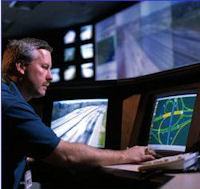by James A. Bacon
The McDonnell administration is tapping Serco., Inc., an English firm with international traffic management experience, to take over Virginia’s five transportation management centers. The six-year deal, announced yesterday, will be implemented as a public-private partnership in a $355 million contract. Thirty-two firms had responded to the state’s Request for Proposal.
Serco will operate Virginia’s five transportation operations centers — in Northern Virginia, Hampton Roads, Richmond, Salem and Staunton — as a consolidated system rather than separate geographic programs.
As highways become increasingly “smart,” or embedded with cameras, sensors, message signs, traffic light actuators and reversible tolled lanes and HOV lanes, the job of managing them has become increasingly complex. Serco manages traffic monitoring and control systems as far afield as Glasgow, Sydney and Hong Kong.
Said Governor Bob McDonnell:
The Commonwealth sought innovation from around the country to deliver the best technology solutions to maximize our transportation system. Virginia is a leader among state departments of transportation in providing real-time traffic information to motorists, and we wanted to build on that reputation. We will use technology more effectively to better manage congestion, freight movement, incidents, severe weather related incidents and traveler information.
Virginia’s traffic-management system includes nearly 900 cameras, 500 electronic message signs and more than 1,000 road sensors. One of Serco’s jobs will be to maintain and improve the reliability of those devices. The company also will manage traffic signal systems, emergency response and traveler information.
“It takes all tools and methods, including technology, operations, and first-class communication systems, in addition to maintenance and construction to make our highway system operate as smoothly as possible,” said VDOT Commissioner Greg Whirley.
Bacon’s bottom line: This appears to be a welcome development. Installing and operating intelligent transportation systems is hardly cost-free but it does represent a major strategic alternative to building more roads and highways. VDOT’s traffic management systems are sophisticated operations (see “Swapping Smarts for Asphalt“) but they probably can be improved upon. Serco can draw upon best practices from its global operations to manage Virginia’s system more efficiently.
A pedestrian example is the management of traffic signals, cameras, sensors, message signs and other devices in the field that go on the blink with some frequency and need continual attention. Serco touts it’s web-based, proactive management system, eWatchman, “which ensures maximum availability of road-side infrastructure.”
However, there was not enough information in the governor’s press release to evaluate the economics of the deal. How much does the $355 million contract compare to VDOT’s internal cost for administering the traffic management systems? Will the public-private partnership save money? If not, will Serco make significant improvements to the system? Even more fundamentally, what performance metrics will Serco be held accountable to achieve, and what is the Return on Investment for additional state dollars spent?
A VDOT “request for information” document, written in January 2012, expressed the hope that the cost of the project would fall “within VDOT’s current budget” for operating the five traffic operations centers, or about $25 million to $35 million per year. “It is expected that this will occur through the delivery of significant operational efficiencies together with potential revenue-generating opportunities.”
The Serco contract will average almost $60 million a year, about twice that number. What happened? Was VDOT simply unrealistic about what it would cost to implement the contemplated improvements? Was the project victim of mission creep? There is more to the story than was released to the public. Inquisitive minds would like to know.



